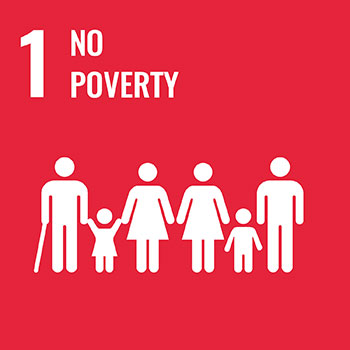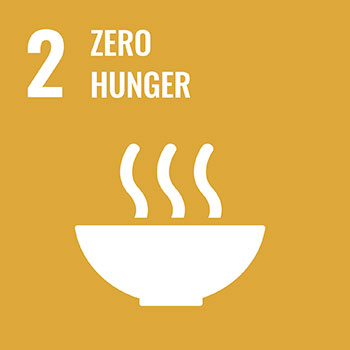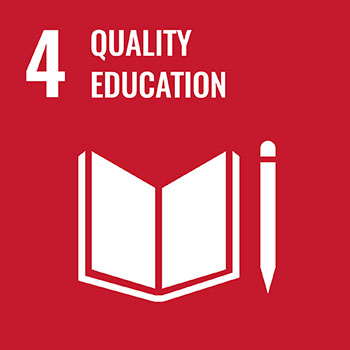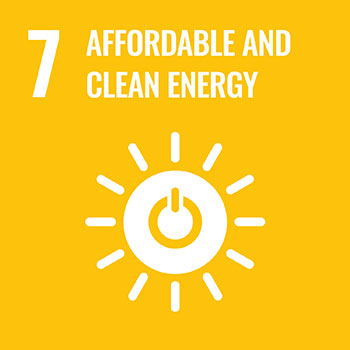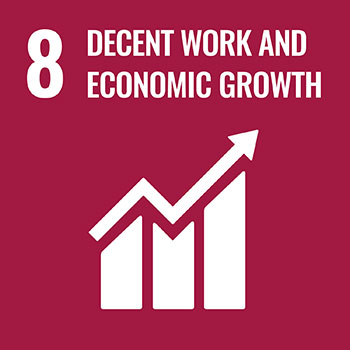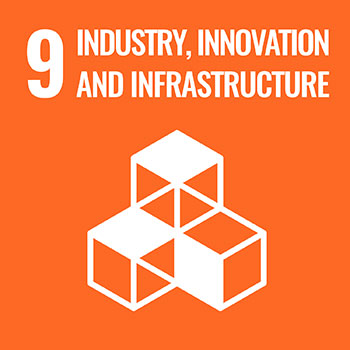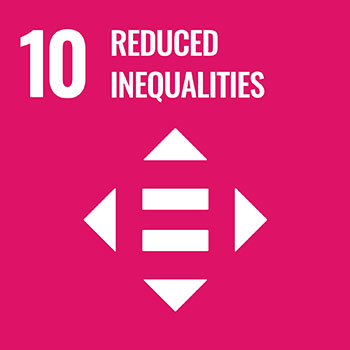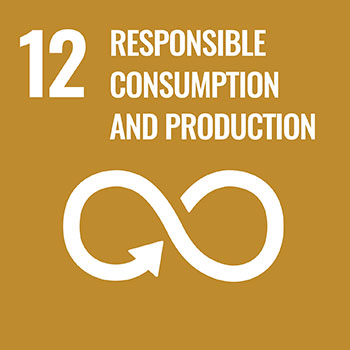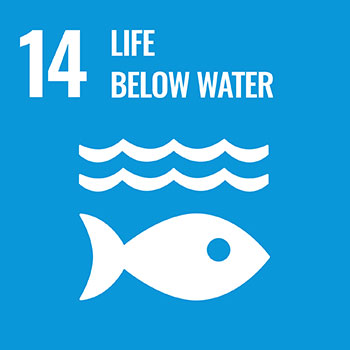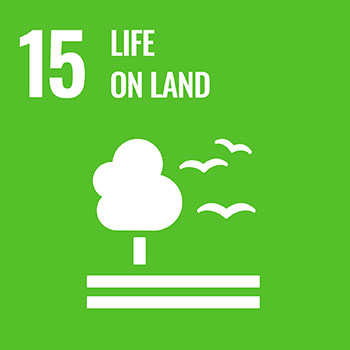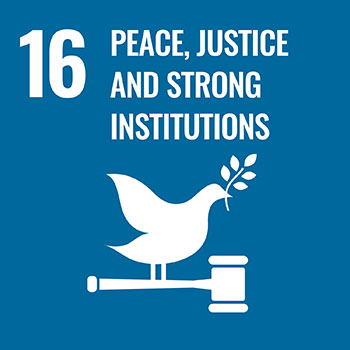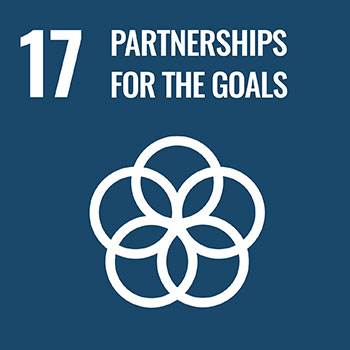Search for academic programs, residence, tours and events and more.

Ensure availability and sustainable management of water and sanitation for all.
By integrating sustainable water management principles into operational practises and engaging in leading academic and research programs related to improving access to safe water resources, Wilfrid Laurier University demonstrates a strong commitment toward achieving SDG 6.
The work that Laurier completed in 2024 to advance SDG 6.
Sheri Longboat (MA ’96, PhD ’13) has always felt a deep personal connection to water. Since her earliest years growing up beside Lake Ontario in Hamilton, Ont., her “reverence and respect” for water has driven her to help protect it. Upon graduating from Wilfrid Laurier University with her master’s degree in 1996, Longboat’s first job was mapping the Haldimand Tract land claim with Six Nations of the Grand River, of which she is a member. She continued to work with Indigenous communities on sustainability and capacity building, noting the “pressing inequality” she observed inspired her to return to Laurier and complete her PhD in 2013. Longboat investigated the lack of water security in many First Nations across Canada, an issue that persists to this day.
Wilfrid Laurier University won gold at the 2024 QS Reimagine Education Awards, chosen as the top submission from Canada and the U.S. across all 18 categories. Laurier was recognized for providing impactful experiential learning opportunities as part of its long-time research partnership with the Government of the Northwest Territories (GNWT), which sees students work alongside community partners to tackle the effects of climate change on northern ecosystems and well-being.
A honey bee apiary project and a Freestore that keeps used household goods out of landfill are among the sustainability initiatives that have earned Wilfrid Laurier University’s Brantford campus a Green Business Award from the City of Brantford.
William Quinton, the Laurier Research Chair in Cold Regions Hydrology, was named the 2024-25 University Research Professor. Quinton is dedicated to developing new knowledge, predictive tools and adaptation strategies for decision-makers and First Nations confronting the effects of climate change in the Northwest Territories. He participated in the formation of Laurier’s longstanding research partnership with the territorial government.
Science and research labs at Wilfrid Laurier University have reduced water consumption by 98% and energy consumption of high-draw equipment by 30% by introducing new, more environmentally sustainable lab practices and processes.
“Labs are fairly energy-intensive spaces,” says Gena Braun, research instrumentation technician in Laurier’s dean of science office. “On average, a lab will use four times the water of a comparable office space and up to 10 times the energy.”
Waste generated from single-use consumables like personal protective equipment can also contribute to a lab’s outsized environmental footprint. That waste, including plastics, is what led Braun to partner with not-for-profit organization My Green Lab.
Laurier research centres advancing SDG 6.
The Laurier Institute for Water Science is a multidisciplinary, collaborative undertaking among research faculty in the Faculty of Arts, the Lazaridis School of Business and Economics and the Faculty of Science. The focus of the institute is on research in three interconnected water-related disciplines:
The Cold Regions Research Centre was established in 1987. Initially focused on arctic and mountain glaciology and hydrology, the scope has broadened to cold regions (mountain and northern) research consulting on topics such as hydrology, climatology, glaciology, resource management, parks planning and biogeochemistry.
Laurier initiatives in 2023 that advanced SDG 6.
Laurier annually measures the total volume of water used by the university at each campus location.
|
Campus |
Total 12-Month Cubic Metre |
Number of Accounts |
|---|---|---|
|
Waterloo |
127,063 |
47 |
|
Brantford |
19,096 |
21 |
|
Kitchener |
138 |
2 |
|
All Campuses |
146,270 |
70 |
Laurier adheres to stringent water quality standards and discharge guidelines to protect ecosystems, wildlife, and human health. Wastewater produced by Laurier is treated by municipal wastewater treatment plants in both the City of Brantford and City of Waterloo. The City of Waterloo Wastewater Services is actively taking steps to ensure continuous delivery of clean drinking water and treatment of wastewater while protecting natural resources. The City of Waterloo oversees operations at 13 wastewater treatment plants and the Ontario Ministry of Environment, Conservation and Parks strictly regulates the operations of these plants to ensure they meet strict environmental quality standards. All treated water leaving treatment plants is monitored to ensure no harm is caused to the natural environment.
The City of Brantford also runs a number of programs to ensure the effective, efficient and sustainable treatment of wastewater.
Laurier complies to all regulations established by the City of Waterloo, City of Brantford and the Province of Ontario including the Ontario Water Resources Act, City of Brantford Sewer Use By-Law and City of Waterloo Sewer Use By-Law to ensure that any material entering the wastewater system does not contaminate the natural environment.
Laurier has a number of processes in place to prevent contaminated water from entering the water systems in its home communities. The institution adheres to all established protocols and regulations set by itself and oversight agencies.
To protect regional waterways, a number of frameworks have been put in place:
Hazardous wastes are wastes that, when present in quantities and concentrations that are high enough, pose a threat to human health or the environment if they are improperly stored, transported, treated or disposed. Hazardous waste must be disposed of responsibly in accordance with Ontario’s Environmental Protection Act, Regulation 347 and Canadian Environmental Protection Act, 1999. Hazardous chemical waste is picked up directly from each lab in accordance with Laurier’s established Hazardous Waste Management Procedure.
Laurier’s Laboratory Safety manual provides detailed guidance on the prevention of chemical spills. Laurier adheres to the Environmental Protection Act and Ontario Regulation 675/98, which require immediate reporting of spills to ensure immediate and effective clean up.
Laurier is committed to providing a safe and healthy environment to all members of the university community, visitors and contractors. The university is potentially subject to natural, technological and human-made emergencies that could threaten the community, its core academic mission, and/or environment. The Emergency Management Policy provides a framework and emergency management plans to prepare the university to deal with events such as chemical spills.
All activities that have the potential to impact water quality are subject to environmental assessment to assess risk and mitigate any potential harm.
Laurier is committed to promoting the efficient use of water among faculty, staff and students. There are 50 free, filtered Elkay waterfill stations at Laurier. The majority of the units also have a fountain provided for those who do not have a reusable water bottle. The units count the amount of plastic water bottles saved. Since installations began in 2014, Laurier has saved more than one million bottles from entering the waste stream.
By including reusable water bottles in student welcome packages, Laurier discourages the use of single-use plastics and promotes a culture of environmental stewardship. The refill stations, strategically located in high-traffic areas, feature digital counters to track the reduction of plastic waste, contributing to Laurier’s broader sustainability initiatives. This approach exemplifies Laurier’s dedication to reducing environmental impacts while fostering responsible behavior among students, staff and faculty.
Recognizing that its activities have an impact upon the environment, Laurier acknowledges a responsibility to protect the environment and the health of the community in all of its activities. As outlined in the institution’s Sustainability Policy, Laurier is committed to sustainability design standards for major projects that will enable the university to work toward Leadership in Energy and Environmental Design (LEED) green building standards for new builds, and introduce principles of sustainable construction, renovations and landscape design. Laurier participates in the LEED program with two certified LEED buildings: the Research and Academic Centre in Brantford (LEED Silver) and Lazaridis Hall in Waterloo (LEED Gold). This third-party certification focuses on innovative design and minimizing resources used during construction, and in consumption of water and energy.
Additionally, the institution has taken steps to retrofit buildings and introduce new approaches to the campus environment to reduce water consumption. These include the installation of 13,000 low-flow water fixtures, the establishment of four green roofs addressing stormwater management and boosting thermal performance, and the introduction of low-impact developments across the grounds featuring native drought tolerant plant species to support pollinators, address stormwater management and reduce water consumption.
Sustainability is one the core principles of Laurier’s Landscaping Masterplan. Laurier is committed to building in environment, social and economic sustainability principles into all aspects of the institution’s landscaping. Ecological principles have been applied to the campus plant community, including prioritizing planting of native, drought-tolerant species. Examples include sumac, Gray Dogwood, Thimbleweed, Broom Sedge, Wild Geraniums and Black-eyed Susans.
Laurier’s Sustainability Policy identifies opportunities to reduce water consumption and implement water conservation measures, including approaches to water reuse.
The institution has created a swale catchment system under a building downspout, a 10,000-litre, below-ground water cistern in a low grade area prone to flooding, and a 2,350-litre, above-ground water cistern. These supply all of our water for grounds maintenance. Laurier also has an area on campus that directs water into a cistern which is used for irrigation. The institution plants native species on hilly areas to stop erosion. At Lazaridis Hall, an underground cistern captures rainwater off the roof for use as grey water throughout the building.
Laurier's water recovery and reuse infrastructure underscores its dedication to sustainable campus operations. At Lazaridis Hall (LEED Gold), a grey water system captures and filters rainwater for use in landscaping and toilets, demonstrating an innovative approach to water conservation. Additionally, Laurier’s Brantford campus, including the LEED Silver-certified Research and Academic Centre, employs a 37,000-litre rainwater harvesting system, alongside a 2,350-litre system, for irrigation purposes. Complementing these efforts are green infrastructure, such as stormwater cisterns, rain gardens, green roofs and bioswales, which further strengthens Laurier's commitment to low-impact development.
The Aquatic Science Outreach Network for the Grand (AquaSONG) is a public, free field trip program for 10th and 11th graders coordinated by Laurier and its Centre for Cold Regions and Water Science. The primary purpose of this field trip is to inform and educate local high school students on the fragility of this local water body, encourage creative collaboration in a laboratory setting, teach basic field sampling techniques and demonstrate methods of analysis. The experience is centred around the concepts of wastewater treatment and analysis, and freshwater aquatic biology.
Laurier researchers are partnering with loca Northwest Territories (NWT) community members to host Water Knowledge Camps. These camps involve shared on-the-land experiences with researchers and community members, including local youth. The design of the camps is two-patterned on the Cross-Cultural Research Camp model for co-production of knowledge established in the Sahtú region, including: interactive experiences with traditional knowledge arising from “way of life” practices on the land; consideration of knowledge and its communication at different scales and from different sources; and science-based research and monitoring education and methods.
World Water Day (WWD) arose from Agenda 21 of the 1992 United Nations (UN) Conference on Environment and Development in Rio de Janeiro, Brazil. The first International World Water Day was commemorated in 1993. Each year, UN-Water, an agency that coordinates the efforts of UN entities and international organizations working on water and sanitation issues, selects a theme to highlight a specific aspect of freshwater. World Water Day is celebrated on March 22.
Since 2010, the Laurier Institute for Water Science (LIWS), along with its graduate student group, has held an annual Graduate Research Fair and Water Celebration. Beginning in 2019, Laurier and LIWS, Global Water Futures and Northern Water Futures have hosted WWD events focussing on regional and northern water issues, including conscious water usage on campus, highlighting the breadth and depth of water research at Laurier and in the Northwest Territories. This event is organized and attended by students, government officials, community groups, industry and non-governmental organizations.
Since 2015, Laurier has dedicated up to $30,000 annually to help grow sustainability ideas that benefit the Laurier community through the Sustainable Hawk Fund (SHF). The program leverages Laurier’s entrepreneurial and community spirit by engaging students, faculty and staff to integrate sustainability practices, including conscious water usage, into all aspects of life at Laurier. For example, in 2023, Laurier launched the ‘My Green Lab’ certification for science research laboratories. This non-credit certificate supports a culture of sustainability on campus by exploring new processes and technologies, sourcing sustainable products, procuring less harmful materials, and reducing waste, energy and water consumption.
Communities throughout the Sahtú, in the Northwest Territories, have expressed concerns about the cumulative impacts of development and climate change on the quality and quantity of the waters in the region and consequent risks to human and ecosystem health. Some of these concerns are related to mining and other industrial developments in the region and beyond. More recently, the impacts of climate change, which include increased frequency of forest fires, changes to hydrological regimes and landscape changes due to permafrost thaw, are adding to these concerns. As a result, many have stopped drinking from local water sources, preferring to purchase drinking water imported from elsewhere. Questions about water quality and ecosystem health are common as livelihoods in the Sahtú are closely linked to their land and waters.
Laurier researchers are partnering with local community members to host Water Knowledge Camps. These camps involve shared on-the-land experiences with researchers and community members, including local youth. The design of the camps is two-patterned on the Cross-Cultural Research Camp model for co-production of knowledge established in the Sahtú region, including: interactive experiences with traditional knowledge arising from “way of life” practices on the land; consideration of knowledge and its communication at different scales and from different sources; and science-based research and monitoring questions and methods.
The Water Knowledge Camps support strengthened frameworks for risk communication and risk management and strengthen the foundation for co-production of knowledge related to water. Project outcomes provide crucial support for the community goals of launching Guardian programs, where community members monitor, observe and report on changes to their lands and water and inform policy related to this and ensure its conservation. By focusing on youth, the hope is to encourage and motivate them to become more involved in the monitoring of their lands and waters and to pursue opportunities in science as a way of becoming leaders in their communities and stewards of their lands.
Water for Laurier’s campus locations is provided by the City of Waterloo and the City of Brantford. Both these cities have source water protection in places as part of a multi-barrier approach to protecting sources of drinking water, such as lakes, rivers and groundwater, before they become contaminated or depleted.
As a result of the Clean Water Act, communities in Ontario are required to develop source protection plans to protect their municipal sources of drinking water. Both Waterloo and Brantford are located in the Grand River watershed. Their source water protection policies are part of the Grand River Source Protection Plan, which is in turn part of the Lake Erie Source Protection Region.
Laurier is a core partner in Global Water Futures (GWF), a pan-Canadian research program that is funded in part by a $77.8-million grant from the Canada First Research Excellence Fund. The goal of the program is to deliver risk management solutions - informed by leading-edge water science and supported by innovative decision-making tools - to manage water futures in Canada and other cold regions around the world where global warming is changing landscapes, ecosystems and the water environment. GWF aims to position Canada as a global leader in water science for cold regions and addresses the strategic needs of the Canadian economy in adapting to change and managing risks of uncertain water futures and extreme events. End-user needs drive strategy and shape science.
GWF is closely linked to a number of institutions, governments and organizations around the world, contributing scientific and technical advancements and dedicated leadership to many key international initiatives. This expands the activities and influence of GWF well beyond Canada to address the issues of global climate and Earth system change and water security.
As part of GWF, Laurier researchers are leading Northern Water Futures, a major multi-disciplinary, multi-partner research project. Northern water security is essential to the vitality of northern communities, the security of traditional food sources and the responsible development of northern resources. Northern Water Futures is supported by strong relationships Laurier has built over time with a diverse network of partners across the Northwest Territories as part of the Laurier-Government of the Northwest Territories Partnership. Northern Water Futures partners with local, regional and territorial governments.
Also as part of GWF, the Matawa Water Futures project was co-developed between Matawa First Nations Management and Laurier following the Matawa Chiefs Council Resolution #11-02-08-18: Watershed Stewardship Capacity Building. The over 180,000 square kilometers of watersheds associated with the Matawa member First Nations homelands form an integral part of their culture and heritage and are directly linked to their sustained health and long-term sustainability. In light of this, and in light of Matawa member First Nations’ intent to lead watershed stewardship within their traditional territories, the Matawa Chiefs resolved to seek opportunities to increase capacity to actively steward community watersheds. The Matawa Chiefs further resolved that all watershed stewardship initiatives will be guided by and centred in community values, priorities and processes and would engage Elders.
Discover how Laurier is contributing to United Nations Sustainable Development Goal targets.
